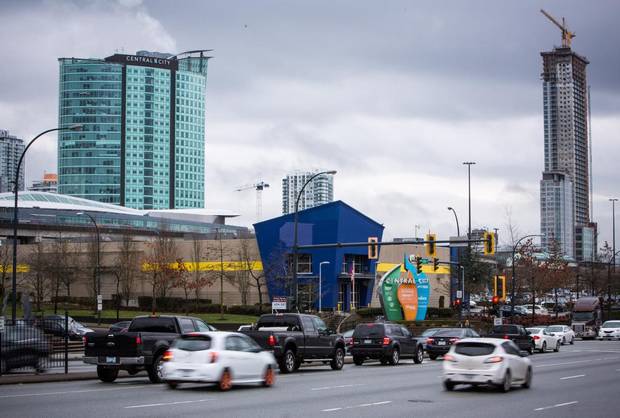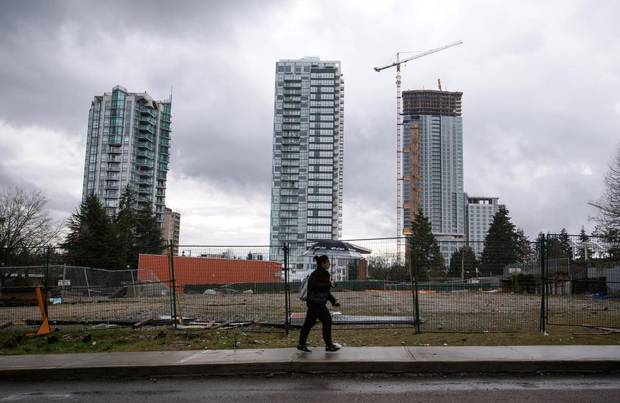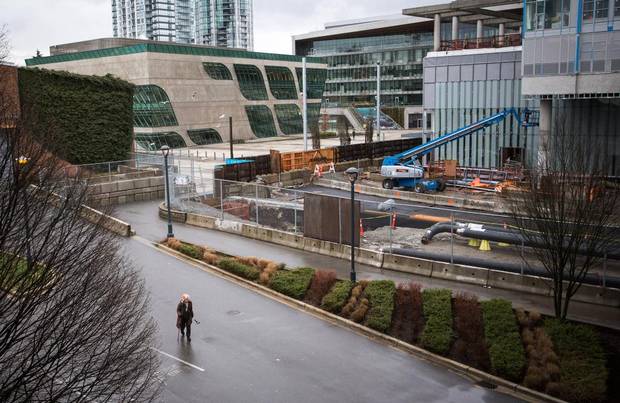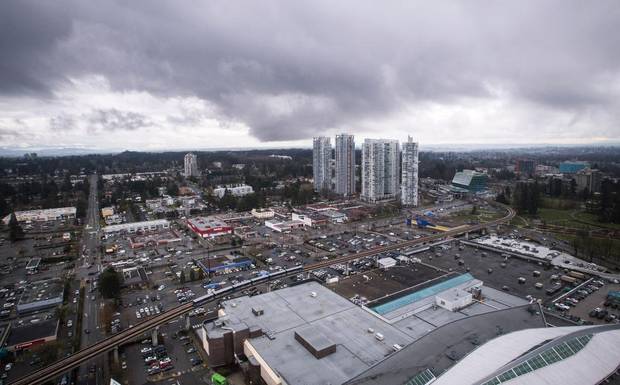It's almost the end of the work day and people are heading home across the plaza in front of what is meant to be Surrey's epicentre, the glamorous Bing Thom tower that houses Simon Fraser University and a mall.
But they're not all streaming to the nearby SkyTrain station to beat it out of the suburbs.
Many, some carrying plastic bags filled with toilet paper, milk, potatoes and light bulbs, are walking home to townhouses and condos that have sprouted around the station in the past decade.
Related: Vancouver's Chinatown threatened by development and demographics
Related: Downsizers cash in – driving the upscale condo market
Related: Vancouver homeowners caught in the middle of a debate about heritage and housing
That is the result of a radical move by then-mayor Dianne Watts 10 years ago to give Surrey a new image, with the vision of a dense, bustling, real downtown as a pillar of that remake.
But as people make their way this afternoon from Surrey Centre to their apartments, the landscape they're travelling through is not exactly Yaletown or the West End.
Instead, beyond the borders of the spiffy block opposite the Thom tower that is now occupied by a new city hall, a new library, and an office and condo tower under construction, a handful of new condo towers and a small swath of low-rise apartments sit awkwardly next to cluster of rundown, mouldy split-levels, empty lots, including one sporting a large hole filled with water and bulrushes, a patch of forest with some felled trees, and a couple of construction projects that haven't made it past ground level yet.
The opposite side of the six-lane, heavy-traffic King George Boulevard is still lined here with a combination of big-box stores and mini-malls.
"People ask 'Why aren't we evolving faster?'" acknowledges Preet Heer, Surrey's community planning manager. "How do you get to that point where there's a shift and people feel something happened?"
It hasn't quite happened yet. There was a big bump of excitement and activity after 2008, when Surrey offered developers special incentives – a break on development cost charges and a three-year moratorium on property taxes – to get them out there. As well, the city built a new city hall and had Bing Thom build a signature library next door.
But there's been a lull in the last year, many say, some publicly, others more quietly. And their observations appear to be borne out by recent census numbers that were analyzed at Metro Vancouver.

Central City in Surrey.
Ben Nelms/for The Globe and Mail
A closer scan shows that Surrey got less than half the number of housing units in its designated city centre than had been projected by the regional plan, for which the city provided its numbers.
While the rest of the huge city of Surrey saw a boom in housing and population, getting about 35 per cent of the 150,000 people who moved into the region between 2011 and 2016, it was a different story for its downtown.
There, it got only 3 per cent of the total amount of new housing – 2,100 of 70,000 units in the region – instead of the 7 per cent planned. The population has grown by only about 14,000, up to 36,000 now, in the past five years.
In comparison, Vancouver's core centre got 11,000 units or 16 per cent, double what had been anticipated. And the rest of the regional centres – Richmond, Burnaby, North Vancouver city, Coquitlam, among others – got 9,000 units, very close to what had been projected.
Chris Vollan, the president of Rize Alliance, acknowledges it's been a hard grind to develop in Surrey.
The company built Wave, a stylish small tower near Surrey Central whose wavy balconies appear to be inspired by famous Chicago architect Jeanne Gang, and with a piece of public art like a lacy spinnaker in front.
"It's very slow absorption in Surrey. The demand wasn't there," said Mr. Vollan, whose company had a second project it planned to develop and then decided to hold off.
"It took us a year to sell the last 40 units [of Wave]. We looked at bringing on Wynd [the second tower] at $450 a square foot and there was very little interest."
Paul Hillsdon, a well-known Twitter commentator on urban issues and a University of B.C. planning student, also feels like there was a lack of momentum for a while.
"It's very different than an actual urban setting," says Mr. Hillsdon, now living in one of the four Concord towers near the King George SkyTrain station, the second cluster of downtown-like density that has emerged in the last five years. "One of the biggest pieces that's missing is just things to do, places to go." There is the Central City Brewpub in the Simon Fraser tower in one direction, a Browns Social House in another, but it's a long hike down a busy street and many parking lots to get to either.

A woman walks by an empty lot behind condo towers in downtown Surrey.
Ben Nelms/for The Globe and Mail
Near where he lives, PCI Developments Corp., the big development company that built the Marine Gateway complex around the last Canada Line station in south Vancouver, has built one stylish office building, the blue- and green-glass covered jewel box that is Coast Capital's headquarters. But there is no sign of when it will develop the two residential towers and office and retail complex talked of previously on the empty land it owns all around that.
What happened?
A few things.
For one, several suburbs closer to Vancouver than Surrey, all on existing or new rapid-transit lines, suddenly exploded with development in the last five years;
New Westminster, Coquitlam and Richmond were among them. And Burnaby moved ahead with densification plans for its four town centres – to the dismay of many residents around the Metrotown neighbourhood who are seeing low-cost housing being mowed down – and developers jumped on a chance to build in a market that was less expensive and almost as busy as Vancouver.
Rize quickly sold out two towers in the Metrotown area with 500 units at the same time it was struggling to market in Surrey, even though the Surrey units cost less. "It's the second strongest market after Vancouver," he said.
Ten towers are planned right at the Brentwood mall in Burnaby, some as high as 60 storeys and with room for 4,200 condos and more than 8,000 people.
Along with that, Surrey hasn't seen the same level of downtown promotion that it did in the early days, say some developers and observers.
"The boosterism has dropped off since the days of Dianne Watts," said Mr. Hillsdon.
There have been some setbacks. One of the perks for developers – lowering or eliminating development-cost charges – was taken away by new provincial legislation, after the development industry complained about the inequity between cities, says current mayor, Linda Hepner.
She's been preoccupied with some serious crime problems since she was elected, but Ms. Hepner insists she is still talking to developers constantly to entice them to come to Surrey.
And, she says, there is a huge amount of development in the pipeline, but some of it likely isn't going to happen until Surrey's planned new rapid-transit project – a light-rail L-shaped line that will connect Surrey Centre to Guildford nearby and Langley, further away – is seen to be moving solidly ahead.
One other factor: Surrey designated a huge area as its central city, 526 hectares – only slightly less than all of Vancouver's downtown and West End. So a cluster of buildings that would seem huge in New Westminster or Richmond's much smaller downtowns seems, in Surrey, like random shoots spread out over a vast plain.
Then there's the other little issue that no one likes to talk about much – the perception that Whalley, the area around Surrey Central, is the small, local version of the Downtown Eastside.
"What probably is a factor is the perceived social problems," says Ken Cameron, the former planning manager for Metro Vancouver, who is a fan of Surrey's vision for a downtown.
He's among many who say Surrey is going to make that breakthrough eventually and that it's doing more things right than some of the other suburbs that are frantically encouraging condos where residents can commute to Vancouver.
"Burnaby and Richmond are always going to be suburbs, but Surrey has a more strategic location because it's in the centre of the most population growth."
And it is actually starting to create jobs near its city centre, notes Mr. Cameron, while other suburbs are not.
The new Surrey Memorial Hospital is a big employer and there's a cluster of related medical enterprises springing up around it. Although only about half a million square feet of office space has been built since 2006, much more is expected.
Mr. Cameron noted there have also been huge investments by various public sectors. SFU is now planning a significant expansion to its campus, while Kwantlen Polytechnic University, which has had campuses scattered around Surrey but never in the centre, is now planning a new campus there.
And, of course, Surrey did spend millions building its city hall, library and plaza at the centre, while it's working on a way to move the 1950s-era skating rink out of the area and possibly partner with the YWCA on a new community facility on the fourth side of the plaza.

A woman walks towards Surrey Central SkyTrain station from Surrey city hall.
Ben Nelms/For The Globe and Mail
There are definite signs that much more investment is coming. Four cranes are visible near Surrey Central. And, beyond that, other towers are still planned by Concord, WestStone, PCI and Rize, some of which will likely go ahead as transit plans are finalized.
And then, there's been a big new purchase.
Anthem, the company that is doing a massive redevelopment at Station Square in Burnaby, one of whose executives is a former prominent Surrey MLA, Kevin Falcon, just bought two giant big-box sites on King George Boulevard, opposite the SkyTrain station.
It has seven towers and a retail complex planned for the current Save-On-Foods and Canadian Tire sites, a development that will bring significant new life to the other side of the boulevard there for the first time.
"I think we have every single element," says Ms. Hepner. She is being pressed to make a few changes, such as reducing the amount of required parking, which would help developers save money and reduce the cost per square foot of units they sell. That's something her council is considering.
And she says she'll soon be announcing in her annual state-of-the-city address a big new economic strategy that will attract even more interest to the city centre.
But, for some, Surrey already feels like a city.
Karen Alvarez, a temporary work-permit holder from Costa Rica, taking a break from work and shopping at the mall, loves it in Surrey. The library is spectacular and "they're building a lot of new places," says Ms. Alvarez, who works at Blenz in Surrey and takes language classes at the mall.
And Adam Fulford, a video-maker currently working in construction, says it's starting to feel like a downtown as he walks through the mall with his shopping.
"They're building it up. And I've noticed more Chinese restaurants." A sure sign.
MORE FROM THE GLOBE AND MAIL:

